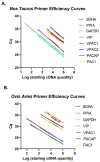Messenger RNA Gene Expression Screening of VIP and PACAP Neuropeptides and Their Endogenous Receptors in Ruminants
- PMID: 36290416
- PMCID: PMC9598725
- DOI: 10.3390/biology11101512
Messenger RNA Gene Expression Screening of VIP and PACAP Neuropeptides and Their Endogenous Receptors in Ruminants
Abstract
Vasoactive Intestinal Peptide (VIP) and Pituitary Adenylate-Cyclase-Activating Peptide (PACAP) are anti-inflammatory neuropeptides that play important roles in human and rodent gut microbiota homeostasis and host immunity. Pharmacologically regulating these neuropeptides is expected to have significant health and feed efficiency benefits for agriculturally relevant animals. However, their expression profile in ruminant tissues is not well characterized. To this end, we screened for VIP and PACAP neuropeptides and their endogenous GPCRs using 15 different tissues from wethers and steers by RT-qPCR. Our results revealed relatively similar expression profiles for both VIP and PACAP neuropeptide ligands in the brain and intestinal tissue of both species. In contrast, the tissue expression profiles for VPAC1, VPAC2, and PAC1 were more widespread and disparate, with VPAC1 being the most diversely expressed receptor with mRNA detection in the brain and throughout the gastrointestinal tract. These data are an important first step to allow for future investigations regarding the VIP and PACAP signaling pathways in livestock ruminant species.
Keywords: PAC1; PACAP; VIP; VPAC1; VPAC2; ruminant; steer; wether.
Conflict of interest statement
The authors declare no conflict of interest.
Figures






Similar articles
-
A cloned frog vasoactive intestinal polypeptide/pituitary adenylate cyclase-activating polypeptide receptor exhibits pharmacological and tissue distribution characteristics of both VPAC1 and VPAC2 receptors in mammals.Endocrinology. 1999 Mar;140(3):1285-93. doi: 10.1210/endo.140.3.6576. Endocrinology. 1999. PMID: 10067855
-
Pituitary adenylate cyclase-activating polypeptide and PACAP receptor expression and function in the rat adrenal gland.Int J Mol Med. 2002 Mar;9(3):233-43. Int J Mol Med. 2002. PMID: 11836629
-
Drug Repositioning For Allosteric Modulation of VIP and PACAP Receptors.Front Endocrinol (Lausanne). 2021 Nov 18;12:711906. doi: 10.3389/fendo.2021.711906. eCollection 2021. Front Endocrinol (Lausanne). 2021. PMID: 34867774 Free PMC article.
-
Signal Transduction by VIP and PACAP Receptors.Biomedicines. 2022 Feb 9;10(2):406. doi: 10.3390/biomedicines10020406. Biomedicines. 2022. PMID: 35203615 Free PMC article. Review.
-
[Physiological significance of pituitary adenylate cyclase-activating polypeptide (PACAP) in the nervous system].Yakugaku Zasshi. 2002 Dec;122(12):1109-21. doi: 10.1248/yakushi.122.1109. Yakugaku Zasshi. 2002. PMID: 12510388 Review. Japanese.
Cited by
-
Influence of vasoactive intestinal polypeptide on growth performance, nutrient digestibility, nitrogen balance, and digestive enzyme activity in lambs.J Anim Sci. 2024 Jan 3;102:skae112. doi: 10.1093/jas/skae112. J Anim Sci. 2024. PMID: 38656435 Free PMC article.
-
The impact of exogenous vasoactive intestinal polypeptide on inflammatory responses and mRNA expression of tight junction genes in lambs fed a high-grain diet.J Anim Sci. 2024 Jan 3;102:skae309. doi: 10.1093/jas/skae309. J Anim Sci. 2024. PMID: 39396104
References
-
- Milani F.X., Wendorff L.W. Goat and sheep milk products in the United States (USA) Small Rumin. Res. 2011;101:134–139. doi: 10.1016/j.smallrumres.2011.09.033. - DOI
-
- Wu Z., Weersink A., Maynard A. Fuel-feed-livestock price linkages under structural changes. Appl. Econ. 2021;54:206–223. doi: 10.1080/00036846.2021.1965082. - DOI
-
- Moss A.R., Jouany J.-P., Newbold J. Methane production by ruminants: Its contribution to global warming. Ann. Zootech. 2000;49:231–253. doi: 10.1051/animres:2000119. - DOI
LinkOut - more resources
Full Text Sources

